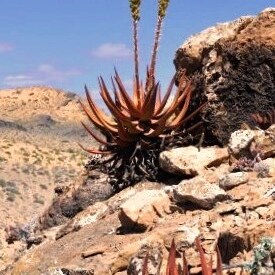Plants usually solitary, the small sub-acaulescent form sometimes branching and forming small groups. Stem varying according to locality from acaulescent or shortly caulescent, simple or branched, procumbent or erect, to simple and 1 met. high, densely covered with the remains of old dried persistent leaves. Leaves densely rosulate, 30-40 cm long, 5-8 cm broad near base, lanceolate-attenuate, usually incurved; upper surface rather flat, somewhat lineate, dull green to reddish-brown, with or without white spots; lower surface convex, similar in lineation and colour to the upper surface, with or without scattered white spots; margins with a somewhat horny edge, armed with reddish-brown, deltoid, pungent teeth 2-3 mm long, about 10 mm distant. Inflorescence simple, up to 80-120 cm high in very robust forms, 3-5 from a rosette simultaneously. Peduncle somewhat biconvex in cross-section low down, terete upwards, with many ovate long-acuminate scarious, many-nerved sterile bracts, the lowest up to 35 mm long, 20 mm broad at base, gradually smaller upwards. Racemes densely flowered, narrowly cylindric-acuminate, 35-50 cm long, 7 cm diam. low down, the youngest apical buds obscured by their longer densely imbricate bracts, older buds horizontally disposed, lowest open flowers cernuous to pendulous. (Note: Two colour forms (a) unicoloured yellow racemes with yellow buds and flowers, (b) reddish buds and yellow flowers, which is less frequent.) Pedicels the lowest 15-20 mm long, gradually shorter upwards. Bracts the lowest nearly twice as long as their pedicels, narrowly lanceolate, thin, pale, sub-scarious, 5-7-nerved, about 25 mm long, 8 mm broad. Perianth mostly yellow or greenish-yellow, cylindric-trigonous, rounded at base, slightly enlarging towards the throat with the mouth slightly upturned, 23-27 mm long; outer segments free but sometimes cohering (not adnate) to the inner for 5-8 mm, with 3-5 nerves confluent at apex, the nerves paler green nearer base deeper green at apex, the apices sub-acute, spreading; inner segments free, broader than the outer, and with a broad white, marginal border, with a prominent green nerve forming a keel, and with more obtuse more spreading brownish tipped apices. Filaments filiform-flattened, the 3 inner narrower and lengthening in advance of the 3 outer, the included portion lemon, the exserted part turning deep brown. Anthers the 3 inner and 3 outer in turn exserted 5 mm Stigma at length exserted 5-6 mm. Ovary oblong, 4 mm long, 2 mm diam., green. Flowering period is from early July near Grootderm, to September near Keimoes.
More
Plants usually solitary, stemless to short-stemmed, up to 1 m tall. Leaves many, lanceolate to deltoid, arcuate-erect to arcuate-incurved, 250-500 x 50-90 mm, dull green to reddish brown, obscurely lined, with or without spots. Inflorescence a simple, very dense, cylindric to conical raceme, 3-5 simultaneously, 0.8-1.2 m tall; peduncle with many sterile bracts; bracts narrowly lanceolate-acuminate, 17-26 x 6-8 mm, 5-7-nerved. Flowers usually yellow, rarely brick-red, 16-27 mm long; pedicels 12-20 mm long, lengthening to ±25 mm in fruit. Anthers exserted 1-5 mm. Ovary 4.0-5.0 x 1.5-2.0 mm, green; style exserted 3-6 mm. Fruit ±14-16 x 8-9 mm, yellow-brown. Seeds ±5 x 2 x 1 mm, black with pale transverse wings at each end. Flowering time July to September.
Short-stemmed, usually solitary, up to 1 m tall. Leaves with numerous longitudinal lines, copiously spotted on both surfaces in young plants, some spots on upper surface in mature plants, unarmed, margins brown, horn-like, with small, sharp, triangular teeth. Flowers in unbranched, narrow, oblong racemes, yellow to greenish yellow, buds sometimes red, hidden by long bracts. (In west) July-Sept. (in east).


